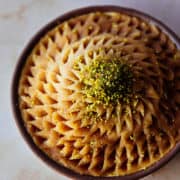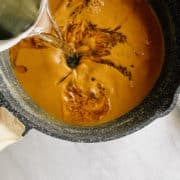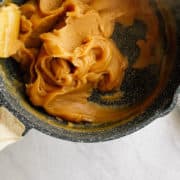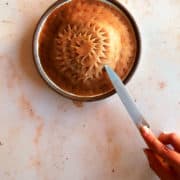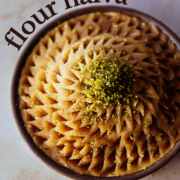Description
A delicious flour halva recipe with the perfect flour, oil, and sugar ratios! Not overly sweet or fatty, un helvasi is a ceremonial Turkish dessert. Vegan with a gluten-free option.
Ingredients
- 2 cups + 2 tablespoons (260g) all-purpose flour (See Note 1)
- scant 1 cup (225ml) sunflower oil (See Note 2)
- scant 1 cup (180g) granulated sugar
- 2 cups (475ml) water
- 1 teaspoon ground Ceylon cinnamon
- 1/4 cup pistachio, finely crushed
Instructions
1. Make the Syrup: Mix the sugar and water in a small saucepan over high heat. Once it starts to boil, turn off the heat and set aside to let cool. Crystallization-preventing ingredients such as citric acid (also found in lemon juice) aren't necessary, but feel free to add a small amount for peace of mind if desired.
2. Sift the Flour: This is important to minimize the chances of clumping. Sift a few times for best results.
3. Make the Roux: Heat the sunflower oil in a large, wide pan on low heat. Gradually add sifted flour while vigorously mixing with a wooden spoon or heatproof spatula. It will become smooth within a minute. For best results, cook the roux on medium heat for 1.5 to 2 hours, stirring the corners and bottom at least once every few minutes so that halva doesn't burn. If you'd like to be done sooner (40-50 minutes instead of 2 hours), cook on high heat and mix continuously.
4. Combine the Syrup with Roux: Once the roux takes a peanut butter color, carefully pour the cooled syrup into the flour paste awayfrom your face. Mix for about a minute, turn off the heat, cover pot with lid or cloth napkin, and let cool.
5. Shape: In Turkey, the most traditional way to shape flour halva is by placing it onto a spoon and smoothing it out with another spoon. This creates perfect little bites. Others like to place all the halva onto one plate and decorating it by making indents. Personally, I like using baking tins or plastic molds to shape halva for an impressive effect. Feel free to simply spoon into bowls for simplicity if you'd like.
6. Serve: Dustwith cinnamon and sprinkle with crushed pistachios if using. Enjoy alongside Turkish coffee or tea, as well as a cup of water, for the most authentic flour halva experience.
7. Save: Refrigerate in an airtight container for up to four days and reheat in a microwave or on the stovetop before serving. You may also freeze flour halva for up to three months.
Notes
1. Flour: Although I haven't personally tested them, I've seen versions made with whole wheat, chickpea, or other gluten-free flours as well. Even though it wouldn't make a traditional flour helva—there are many substitutions that could work well. For example, in India, "besan ka halwa" is a popular dessert made with split brown chickpea flour (gram flour).
2. Oil: Sunflower oil works very well. You could also use grapeseed, canola, or any other neutral oil. Olive oil (especially if fresh and extra-virgin) tastes a little too savory in a helva. Note that many people prefer using butter in helva, at least partially. Owing to the long toasting process of the flour as a roux is made, there's incidentally a flavorful browned butter. Personally, I find even vegan butter to be a bit too heavy in this dessert. Feel free to substitute the oil completely or partially with vegan butter (this one browns!) if you like its flavor more. Butter (including most vegan butter) is 18% water so if you do replace the oil with it, make sure to increase the amount of butter accordingly.
- Prep Time: 10 minutes
- Cook Time: 1 hours 30 minutes
- Category: Dessert
- Method: Cook
- Cuisine: Turkish, Middle Eastern, Indian
